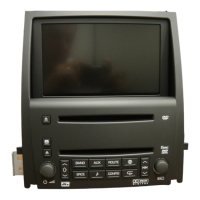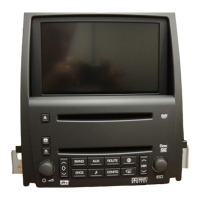
Do you have a question about the Cadillac STS 2011 and is the answer not in the manual?
| Brand | Cadillac |
|---|---|
| Model | STS 2011 |
| Category | Automobile |
| Language | English |
Overview of the vehicle's dashboard layout, including gauges, indicators, and controls.
Brief overview of important features for the first drive and vehicle operation.
Instructions for using the keyless transmitter to lock and unlock doors remotely.
Procedure to start the vehicle's engine remotely from outside.
Explanation of various methods for locking and unlocking the vehicle's doors.
Information on operating the power window switches and their functions.
Details on adjusting power seats, including forward/rearward, cushion height, and seatback recline.
Instructions for adjusting exterior and interior mirrors, including automatic dimming features.
Guide to adjusting the power tilt and telescopic steering column for optimal position.
Overview of the vehicle's heating, cooling, and ventilation system controls.
Information on the driver shift control (DSC) for manual-like transmission operation.
Description of various vehicle features like radio, Bluetooth, and navigation systems.
Explanation of the DIC display and its buttons for vehicle system status.
How to program features to preferred settings for drivers, including seat and mirror positions.
Instructions for operating the cruise control system and setting vehicle speed.
Overview of traction control, StabiliTrak, tire pressure monitoring, and engine oil systems.
Information on available roadside assistance services and how to contact them.
Details on accessing online resources for vehicle information, service records, and dealer support.
Information about the OnStar system and its safety, security, and convenience services.
Details on power seat adjustment, lumbar support, heating, ventilation, and memory settings.
Information on rear seat features, including heating and pass-through access.
Guidance on proper safety belt usage, including for pregnancy and special situations.
Instructions for securing older children and infants using child restraint systems.
Explanation of the LATCH system for securing child restraints and locating anchors.
Details on airbag locations, operation, and safety precautions.
Guidance on checking safety belt systems and replacing parts after a crash.
Information on the keyless access transmitter and its use with the vehicle.
Details on locking and unlocking doors, including power locks and security features.
Instructions for operating power windows, including express features and anti-pinch override.
Description of sun visor operation and integrated vanity lamp controls.
Overview of the vehicle's theft-deterrent alarm system and its operation.
Guidance on new vehicle break-in, ignition positions, and starting the engine.
Information on exterior and interior mirror adjustments, including automatic dimming and park tilt.
Explanation of systems like Ultrasonic Rear Parking Assist (URPA) and Side Blind Zone Alert (SBZA).
Details on the LDW system's operation, warnings, and detection capabilities.
Instructions for programming and using the remote system for garage door openers and security systems.
Locations and usage of various storage compartments within the vehicle.
Guide to programming driver preferences for seat, mirror, and steering wheel settings.
Introduction to the instrument panel, including gauges, indicators, and controls.
Instructions for operating the hazard warning flashers to alert other drivers.
Guide to adjusting the steering wheel position for driver comfort and safety.
Explanation of the lever's functions for turn signals, lane changes, and headlamp controls.
Details on operating headlamps, including automatic lighting and IntelliBeam system.
Instructions for operating windshield wipers and washers, including delay and speed settings.
Overview of the dual climate control system, automatic, and manual operation modes.
Explanation of various warning lights, gauges, and indicators on the instrument panel.
Diagram and explanation of the instrument cluster layout and its components.
Detailed guide on DIC operation, displays, messages, and system information.
Information on operating the radio, CD player, and other audio system features.
Instructions for using the Bluetooth system for hands-free calls and voice commands.
Overview of the navigation system's capabilities for maps and route guidance.
Guide to customizing radio features, including presets, tone, and equalizer settings.
Instructions for setting, resuming, and canceling cruise control for speed maintenance.
Explanation of the adaptive cruise control system for maintaining distance and speed.
Information on accessory power outlets for charging electronic devices.
Details on how the traction control system limits wheel spin and operates.
Explanation of the vehicle stability enhancement system and its operation.
Information about the Tire Pressure Monitor System (TPMS) and its warning light.
How the engine oil life system calculates and indicates the need for an oil change.
Tips and habits to improve fuel efficiency while driving the vehicle.
Information on how to contact roadside assistance and the services provided.
Access to online resources for vehicle information, service records, and dealer support.
Details on the OnStar system and its safety, security, and convenience services.
Explanation of how the automatic crash response system alerts advisors in a crash.
General advice on driving habits, awareness of road conditions, and vehicle control.
Principles of defensive driving, including anticipating others and focusing on the task.
Serious warnings about the dangers and effects of drinking and driving.
Explanation of how brakes, steering, and accelerator systems control the vehicle.
Information on perception and reaction time in braking, and stopping distances.
Details on how ABS works to prevent braking skids and how to use it effectively.
Guidance on using steering and braking in emergency situations.
Explanation of the vehicle stability enhancement system and its operation.
Details on how the traction control system limits wheel spin and operates.
Information on how the AWD system distributes engine power to all wheels.
Information on power steering, speed variable assist, and active steering systems.
Tips and safety rules for safely passing other vehicles on the road.
Advice on what to do in emergency situations to regain vehicle control.
Tips and precautions for driving safely during nighttime conditions.
Advice for driving safely on wet roads, including hydroplaning prevention.
Checklist of vehicle preparations and services before embarking on a long journey.
Tips for driving on steep inclines and descents, including brake and engine management.
Guidelines for driving safely in snow and ice conditions, including tire and system recommendations.
Methods for freeing a stuck vehicle, including using traction systems and rocking techniques.
Information on determining correct load limits and weight distribution for vehicle safety.
Overview of towing procedures, including vehicle preparation and trailer considerations.
Information on obtaining genuine GM parts and service from dealers.
How non-dealer accessories can affect vehicle performance, safety, and warranty.
Warning regarding chemicals in vehicles known to cause cancer or reproductive harm.
Safety precautions and requirements for performing vehicle maintenance tasks yourself.
How external additions can affect airflow, fuel economy, and washer performance.
Recommendations for using TOP TIER Detergent Gasoline for engine cleanliness and performance.
Guidance on selecting the correct octane rating and potential issues with lower ratings.
Details on required gasoline specifications and warnings about MMT and methanol.
Information on fuel system additives like GM Fuel System Treatment PLUS.
Advice on finding proper fuel when driving outside the United States or Canada.
Safety instructions for refueling the vehicle and handling fuel vapor.
Safety guidelines for filling portable fuel containers, avoiding static discharge.
Guide to checking engine oil, coolant, washer fluid, and other underhood components.
Instructions on how to locate and operate the hood release lever.
Diagram and identification of engine compartment components and sight shields.
Importance of proper engine oil, selection, checking, and changing.
How to reset the engine oil life system after an oil change.
Instructions for inspecting and replacing the engine air cleaner/filter.
Information on checking and changing automatic transmission fluid, including correct fluid type.
Explanation of the cooling system's function and components.
Details on DEX-COOL engine coolant, its properties, and maintenance requirements.
Information on indicators of engine overheating and protection modes.
Guidelines for maintaining the vehicle's interior and exterior appearance.
Methods for cleaning interior surfaces like upholstery, leather, and plastics.
Techniques for cleaning fabric and carpet using vacuuming and specialized solutions.
Recommendations for cleaning and preserving leather surfaces, avoiding damaging products.
Care instructions for plastic surfaces to avoid altering appearance or causing reflections.
Cleaning instructions for wood interior trim to maintain its appearance.
Gentle cleaning methods for speaker covers to avoid damage.
Guidelines for cleaning safety belts to ensure their effectiveness and prevent weakening.
Tips for maintaining weatherstrips to ensure proper sealing and longevity.
Best practices for washing the vehicle to preserve paint finish and avoid damage.
Instructions for cleaning exterior lamps and lenses using mild solutions.
Advice on waxing and polishing the vehicle's paint finish, including basecoat/clearcoat care.
Care instructions for aluminum and chrome wheels, avoiding damaging cleaners and car washes.
General information on tire maintenance, inspection, and replacement.
Importance of cleaning the underbody to prevent corrosion from road chemicals.
Information on damage caused by airborne pollutants and GM's warranty coverage.
Location and importance of the Vehicle Identification Number (VIN) and engine code.
Information on add-on electrical equipment and its potential impact on vehicle systems.
Explanation of circuit breakers protecting power options and their operation.
Guide to identifying and replacing fuses and understanding circuit breaker functions.
Importance of maintenance for vehicle condition, performance, and warranty coverage.
Guidance on when to perform maintenance based on mileage, time, and message displays.
List of routine checks and services the owner can perform for vehicle upkeep.
Specifications for fluids and lubricants required for vehicle maintenance.
List of common replacement parts with GM and ACDelco part numbers.
Diagram illustrating the routing of the engine drive belt for the 3.6L V6 engine.
Template for recording vehicle service dates, odometer readings, and services performed.
Information on contacting Cadillac for assistance and the customer satisfaction process.
Steps for resolving concerns, from dealership contact to external dispute resolution programs.
Access to customized vehicle information, service records, and dealer support online.
Contact information for TTY users needing assistance from Cadillac.
Contact details for Cadillac Customer Assistance in the US, Canada, and overseas.
Information on program availability for eligible aftermarket adaptive equipment reimbursement.
Details on roadside assistance services, coverage, and calling procedures.
Guidance on scheduling service appointments and minimizing inconvenience.
Information on transportation options provided during warranty repairs.
Recommendations for choosing repair facilities and using quality replacement parts.
How to report safety defects to government agencies and General Motors.
Explanation of vehicle data recording, event data recorders, and privacy policies.
Information on the OnStar system, data collection, and services.
Reference to the navigation system manual for stored data and deletion instructions.
Explanation of RFID technology used for vehicle functions like tire pressure monitoring.
FCC and Industry Canada compliance statement for vehicle radio frequency systems.












